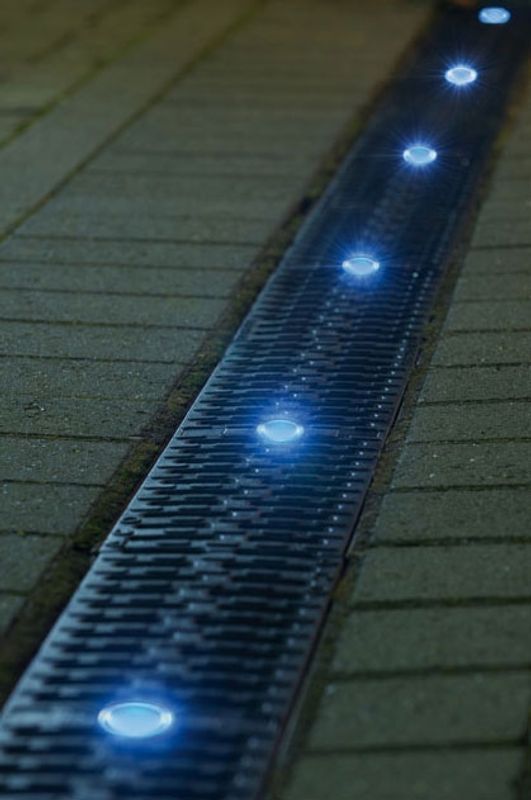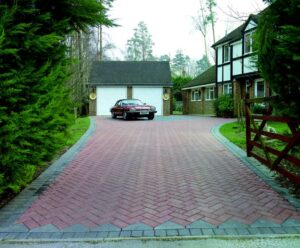Have you recently finished work on a brand-new driveway? Congratulations!
A neat driveway is both a practical necessity and a valuable asset to your property that can improve your kerb appeal substantially.
However, your driveway won’t be much use if it constantly floods, right?
To stop this from happening, you need the right driveway drainage solution. And to help you find the ideal solution, at Drainage Superstore we decided to put together the ultimate guide to driveway drainage.
Here’s what we’re going to cover.
Table of contents:
- What is proper drainage for a driveway?
- Choosing the right driveway drainage
- Driveway drainage regulations in the UK
- How to install a driveway drainage channel
- How do I improve the drainage on my gravel driveway?
- The importance of driveway drainage
What is proper drainage for a driveway?

Driveway drainage is essential for maintaining the functionality and longevity of your driveway, especially in the UK where heavy rainfall is quite common.
The thing is:
Proper driveway drainage helps prevent various issues, including flooding, erosion and damage to the driveway surface and the rest of your property.
Here’s why driveway drainage is important:
Prevents flooding
Here in the UK, we experience frequent rainfall. So, poor driveway drainage can lead to standing water or flooding, making your driveway unusable and potentially causing structural damage.
Prevents erosion
Inadequate drainage can erode the driveway surface, causing it to deteriorate over time. This can lead to costly repairs and decreased aesthetic appeal. Either way, it’s bad news.
Prevents property damage
Poor drainage can direct water towards your home’s foundation, causing potential structural damage and dampness issues. This is a huge issue!
Improves safety
Standing water on a driveway can be a safety hazard, increasing the risk of slipping and accidents.
Choosing the right driveway drainage
When choosing a driveway drainage system in the UK, it’s important to consider factors like local rainfall patterns, soil type and the driveway’s construction materials.
What’s more:
Proper installation and maintenance of the chosen driveway drain system are crucial to ensure it functions effectively over time.
With that in mind, here are the most common driveway drainage solutions available on the market.
Gravel driveways with a permeable membrane

Gravel driveways are porous, allowing rainwater to seep through. To enhance drainage, a permeable membrane or geotextile fabric can be placed beneath the gravel to prevent weed growth and encourage water infiltration.
Channel drains

Channel drains are long, narrow drains installed at the edge of the driveway or in the middle to capture surface water and direct it away. Available in various weight load classes, they’re highly effective at preventing surface flooding.
Want to find out more? Check out our guide on how to select the right channel drain.
French drains

A French drain is a gravel-filled trench with a perforated pipe that collects water and channels it away from the driveway. This is a good option for driveways located on slopes or in areas with poor soil drainage.
Check out our guide on how to install a French drain to find out more.
Driveway drainage grates

Drain grates are placed at strategic points on the driveway and are connected to an underground drainage system. They allow water to flow into pipes or channels, preventing surface water buildup.
Sloped driveways
Proper design with a slight slope can encourage water to run off the driveway and into a designated drainage area. This method is common in driveways with paving or concrete surfaces.
Driveway soakaway
A soakaway is an underground storage area designed to collect rainwater and allow it to gradually disperse into the ground. While it’s an environmentally friendly option that will help reduce your carbon footprint, you should keep in mind that soil conditions must be suitable for efficient water absorption.
Ditching and landscaping
Effective landscaping techniques, such as grading the land or creating swales and ditches, can divert water away from the driveway and towards suitable drainage outlets.
What is the drainage angle for a driveway?
The drainage angle for a driveway typically ranges between 1% to 2%, or 1/8″ to 1/4″ of slope per foot. This slope is designed to ensure effective water runoff and prevent standing water on the driveway surface.
Here’s how the drainage angle works:
A 1% slope is equivalent to a 1/8″ drop in elevation for every 1 foot of horizontal distance. For example, if you have a 20-foot-long driveway, it should have a 1/8″ x 20 = 2.5″ of elevation drop from the high point to the low point to provide a 1% slope.
A 2% slope is double the angle of a 1% slope, with a 1/4″ drop in elevation for every 1 foot of horizontal distance.
The choice of slope depends on various factors, including local drainage conditions, the type of driveway surface and the volume of rainfall in your area.
Driveway drainage regulations in the UK
Driveway regulations in the UK exist specifically to prevent flooding and the presence of standing water. Introduced on 1 October 2008, they state that if your driveway is bigger than five square metres in size, you have to incorporate a suitable drainage solution. If you don’t, you simply won’t get planning permission.
The good news is:
Planning permission is not required for a new or replacement driveway, regardless of its size, as long as it employs permeable (or porous) materials like gravel, permeable concrete block paving or porous asphalt. Likewise, if rainwater is naturally directed to a lawn or border for drainage, planning permission is not necessary.
So, in case you were wandering – do I need to put drainage on my driveway? – you now have your answer.
To find out more about the regulations covering drainage for a driveway, check out the official government Guidance on the permeable surfacing of front gardens document.
How to install a driveway drainage channel

Channel drainage from leading manufacturers like ACO, Clark Drain and Hauraton is one of the most popular driveway drainage solutions with the engaged homeowners in the UK.
And if you too are considering a heavy duty channel drain, you probably want to know how to install it.
In brief, the process consists of the following steps:
- Clear area to fit a trench
- Dig the trench
- Fill the trench with level sand and concrete
- Lay down the drain
- Place the grate
To find out more about channel drain installation, head over to our in-depth guide. Also, don’t forget to clean your channel drain on a regular basis to keep it in good working order!
How do I improve the drainage on my gravel driveway?

To improve your gravel drive drainage, there are a few steps you can confidently take.
Here’s the scoop:
Firstly, consider adding a layer of geotextile fabric, also known as a weed barrier, beneath the gravel surface. This fabric helps prevent weeds from growing through the gravel while still allowing water to penetrate.
Additionally, it aids in stabilising the gravel, reducing erosion and improving drainage. Make sure to spread it evenly and secure it properly to the ground.
Secondly, assess the slope and grading of your driveway. Ensure it has a subtle but consistent slope from the high point to the low point, allowing water to flow away from the centre of the driveway.
Now:
If you have a relatively flat or uneven driveway rather than a sloping driveway, consider regrading the area to achieve the desired slope. You may also want to install a channel drain or a French drain at strategic points along the driveway’s edges to collect and divert water away from the surface.
Last but not least:
Proper maintenance, such as regular raking and replenishing the gravel to maintain the slope and fix any low spots, can further improve your gravel driveway’s drainage capabilities.
The importance of driveway drainage

Proper driveway drainage is an essential component of any driveway in the UK to prevent flooding – especially during the rainy season!
The good news is:
Thanks to our driveway drainage guide, you now know what the government regulations are and what driveway drainage solutions you can choose from.
The best part?
With a variety of options available at Drainage Superstore, you can be confident you can easily find the right one for your specific needs without breaking the bank!

























